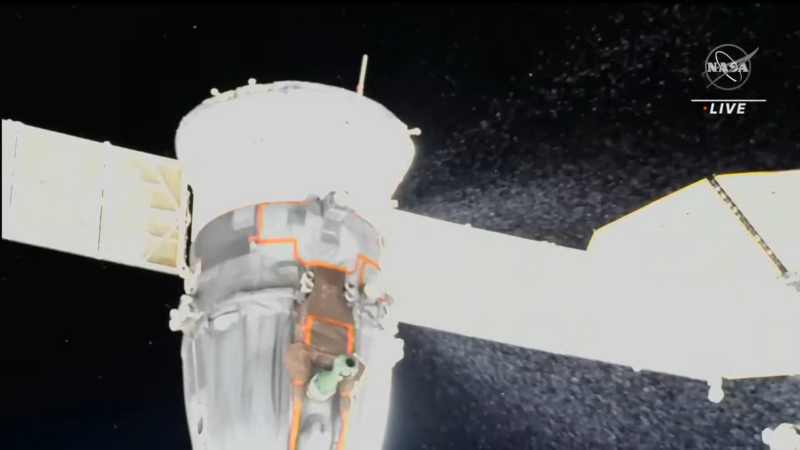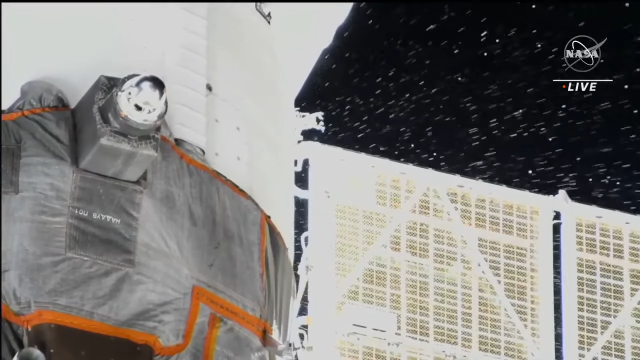A Russian spacecraft started leaking uncontrollably on Wednesday night
After three hours Wednesday night, the leak remained ongoing.

A view of the aft end of the Soyuz spacecraft leaking what appears to be ammonia on Wednesday night.
NASA TV
A Russian spacewalk was canceled at the last minute on Wednesday night when a spacecraft attached to the International Space Station unexpectedly sprang a large leak.
Cosmonauts Sergey Prokopyev and Dmitri Petelin were dressed in spacesuits, with the airlock depressurized, when flight controllers told them to standby while the leak in a Soyuz spacecraft was investigated. The spacewalk was subsequently called off shortly before 10pm ET (03:00 UTC Thursday).
The leak appears to have originated in an external cooling loop located at the aft end of the Soyuz MS-22 spacecraft. Public affairs officer Rob Navias, who was commentating on the spacewalk for NASA Television, characterized the spacecraft as leaking "fairly substantially." Video of the coolant leak showed particles streaming continuously from the Soyuz, a rather remarkable sight.
At no time were any of the crew members on the space station in danger, including Prokopyev and Petelin, their fellow cosmonaut Anna Kikina; NASA astronauts Frank Rubio, Nicole Mann, and Josh Cassada; and Japanese astronaut Koichi Wakata. The leak was external to the station, not inside the orbiting laboratory.
However, the leak does raise questions about the viability of the Soyuz spacecraft, which is the ride back to Earth for Prokopyev, Petelin, and NASA's Frank Rubio. They launched to the space station back in September on board this Soyuz vehicle and are due to return to Earth next spring. After three hours Monday night the leak remained ongoing, showing no sign of abating.
The Soyuz is a hardy spacecraft, so it is plausible that there may not be any impact on its ability to undock from the space station and return to Earth. However, if Russian engineers—and those from NASA, considering that Rubio will be on board—determine there is an issue, a replacement Soyuz would need to be flown up to the station. Soyuz vehicles do have the capability to launch and dock autonomously. However, it would mean that, until such time as the replacement spacecraft arrived, the three crew members would have no emergency escape vehicle.

Enlarge / Three hours after the leak was initially detected, it remained ongoing.
NASA TV
The other four astronauts on board the station flew up on a SpaceX Crew Dragon spacecraft in October. That vehicle cannot accommodate seven people for a return to Earth.
Given the long duration of the leak, NASA is also likely to have concerns about the impact of all that ammonia on space station surfaces and those of other docked vehicles. Much of the ammonia would probably boil off the surface of the hardware over time, but it will certainly complicate operations as the US space agency works toward conducting a spacewalk of its own on December 19 to install new solar arrays.

WASHINGTON — A coolant leak in a Soyuz spacecraft docked to the International Space Station Dec. 14 forced flight controllers to cancel a Russian spacewalk there and raised questions about the spacecraft’s ability to return to Earth safely.
Cosmonauts Sergey Prokopyev and Dmitri Petelin were preparing for a spacewalk when station controllers noticed a coolant leak in the service module of the Soyuz MS-22 spacecraft docked there at approximately 7:45 p.m. Eastern. That spacecraft delivered Prokopyev and Petelin, along with NASA astronaut Frank Rubio, to the station nearly three months ago.
The two cosmonauts continued their spacewalk preparations but remained in the airlock as engineers on the ground assessed the problem. Their seven-hour spacewalk was scheduled to begin at about 9:20 p.m. Eastern, but was delayed and ultimately canceled shortly before 10 p.m. Eastern. The leak, visible as a stream of particles from the Soyuz, was visible more than three hours after it started in NASA TV coverage.
“The best plan of action tonight was focus all of our Moscow team’s attention on sorting out what’s going on exactly with the Soyuz spacecraft and then we’ll regroup tomorrow,” Emily Nelson, NASA chief flight director at the Johnson Space Center, said in comments on NASA TV around midnight Eastern.
The Russian space agency Roscosmos, in a brief statement Dec. 15, said there was “damage to the outer lining” of the service module of the Soyuz, but didn’t offer more details on the problem. Roscosmos said a third Russian cosmonaut on the station, Anna Kikina, used a robotic arm to perform a photographic inspection of the spacecraft, returning those images to Earth for analysis.
Both the cause and the severity of the leak are unclear. The leak did not pose any immediate risk to the station and its crew, but in a worst-case scenario, it would render the Soyuz spacecraft unable to return to Earth safely with its crew.
Roscosmos could launch the next Soyuz to the station without any crew on board as a replacement, but it’s uncertain when the spacecraft, Soyuz MS-23, could be prepared for launch, and doing so would affect future crew rotations. Soyuz MS-23 is currently scheduled to launch to the station in March 2023 with two Roscosmos cosmonauts and one NASA astronaut.
The risk of a problem with either Soyuz or U.S. commercial crew
vehicles is a major reason why NASA had, for years, sought to exchange
seats between such spacecraft in a barter arrangement. That would mean
there would be at least one NASA astronaut and one Roscosmos cosmonaut
on the station at any time should either Soyuz or commercial crew
vehicles be out of service for an extended period..." READ MORE
X
.jpg)
.jpg)
.jpg)


No comments:
Post a Comment